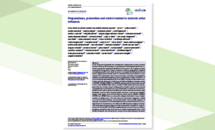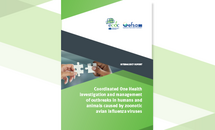
Credit CDC Antigenic Characterization#18,591
While an H5 pandemic is in no way certain, one of the burning unanswered questions in the world of virology is: `If HPAI H5 were to spark a pandemic, how much pre-existing immunity is there in the general population?'
Since we've not seen an H5 influenza pandemic before (at least in living memory), the assumption has been `little or none'.
Last summer the CDC released a report (CDC A(H5N1) Bird Flu Response Update: Population Immunity to A(H5N1) clade 2.3.3.4b Viruses) which - based on an analysis of sera (blood) collected from people of all ages in all 10 HHS regions - found:
Data from this study suggest that there is extremely low to no population immunity to clade 2.3.4.4b A(H5N1) viruses in the United States. Antibody levels remained low regardless of whether or not the participants had gotten a seasonal flu vaccination, meaning that seasonal flu vaccination did not produce antibodies to A(H5N1) viruses.
This means that there is little to no pre-existing immunity to this virus and most of the population would be susceptible to infection from this virus if it were to start infecting people easily and spreading from person-to-person. This finding is not unexpected because A(H5N1) viruses have not spread widely in people and are very different from current and recently circulating human seasonal influenza A viruses.
But at the same time we've seen evidence which suggests that H5 viruses have a preference for infecting, and often killing, young people (see A Predilection For The Young). Curiously, in China's 5 year battle against H7N9 - the opposite was true - with those under 40 far less affected (see comparison chart below).
In 2016's Science: Protection Against Novel Flu Subtypes Via Childhood HA Imprinting, we looked at research which suggested the influenza HA Group type you are first exposed to makes a significant, and lasting, impression on your immune system.
- Those born prior to the mid-1960s were almost certainly first exposed to Group 1 flu viruses (H1N1 or H2N2)
- Those born after 1968 and before 1977 would have been exposed to Group 2 (H3N2)
- After 1977, both Group 1 and 2 viruses co-circulated, meaning the first exposure could have been to either one.
We've also seen some research that suggests exposure to H1N1
(or the seasonal flu shot) may provide some limited protection, since the the NA gene segment in seasonal H1N1 virus is antigenically similar to the NA in the clade 2.3.4.4b H5N1 virus (see
EID Journal: A(H5N1) NA Inhibition Antibodies in Healthy Adults after Exposure to Influenza A(H1N1)pdm09).
A major caveat is, most of the studies we've seen over the past year have focused on the `bovine' B3.13 genotype of H5N1, which is just one of scores of H5 (subtypes/genotypes) circulating around the globe. It has been uncharacteristically mild in humans (compared to historical H5 strains), and their results may not apply across the board.
But even if they do apply, the levels of immunity being reported in these studies have been quite limited. All of which brings us to a new preprint, published this week in the BioRxiv, published by researchers at the University of Cologne, Germany.
They describe finding `low but detectable' levels of pre-existing immunity to the H5N1 B3.13 genotype, but are unable to predict how much protection (if any) they might afford.
The full report runs 31 pages, so I've only posted the abstract and a few excerpts. Follow the link to read it in its entirety. I'll have a brief postscript after the break.
Detection of low pre-existing humoral immunity against influenza virus H5N1 clade 2.3.4.4b in unexposed individuals
Katharina Daniel, Leon Ullrich, Denis Ruchnewitz, Matthijs Meijers, Nico Joel Halwe, Ursula Wild, Jan Eberhardt, Ricarda Stumpf, Maike Schlotz, Marie Wunsch, Luana Girao Lessa, Christopher Dietrich, Andreas Pinger, Anna-Lena Schumacher,Maximilian Germer, Malena Rohde, Christian Kukat, Lutz Gieselmann, Henning Gruell, Donata Hoffmann, Martin Beer, Thomas Erren, Michael Lässig, Christoph Kreer, Florian Klein
doi: https://doi.org/10.1101/2025.01.22.634277
This article is a preprint and has not been certified by peer review [what does this mean?].
Preview PDF
Abstract
The repeated spill-over of Influenza A virus H5N1 clade 2.3.4.4b from cattle to humans highlights the risk of a human H5N1 pandemic. Given the impact of pre-existing immunity on the course and severity of viral infections, we assessed in detail the humoral immunity against the H5N1 A/Texas/37/2024 isolate in H5N1-naïve individuals.
To this end, we performed complementary binding and neutralization assays on 66 subjects and ranked activities among a panel of 76 influenza A virus isolates. We detected low but distinct cross-neutralizing titers against A/Texas/37/2024 with a 3.9 to 15.6-fold reduction compared to selected H1N1 or H3N2 strains.
Moreover, by cloning and evaluating 136 monoclonal antibodies from single memory B cells, we identified potent A/Texas/37/2024-neutralizing monoclonal antibodies in five out of six investigated individuals. These antibodies predominantly utilize VH1-69 gene segments, cross-neutralize H1, and compete with antibodies targeting the HA stem. Our findings demonstrate partial pre-existing humoral immunity to A/Texas/37/2024 in H5N1-naïve individuals.
(SNIP)
In summary, we demonstrate detectable but low levels of A/Texas/37/2024 humoral
immunity in H5N1-naïve individuals with the presence of memory B cells that encode for
potent H5-neutralizing antibodies. This is in contrast to the lack of cross-neutralizing
antibodies for SARS-CoV-2 before the emergence of the Covid-19 pandemic (50, 51).
However, in our study, we neither infer risks for H5N1 transmission from cattle to humans
nor within the human population. Moreover, as we have learned from influenza and other
viral pathogens, single mutations can be sufficient to mediate viral escape from humoral
immunity as well as from antibody therapeutics (52–55). Therefore, further studies are
needed to determine reliable correlates of protection for newly emerging influenza virus
variants.
Limitations
This study is subject to the following limitations. First, the cohort is restricted to 66
individuals from the local area of Cologne, Germany and exhibits an above-average
vaccination rate of 70%. Second, only a limited number of 6 individuals from this cohort
were subjected to single B cell analysis. Third, direct comparison of neutralizing activity
between human and avian HA subtypes might be affected by different preferences for α2-
6- over α2-3-linked glycans: Human and avian influenza A virus subtypes differ in their
specificity for α2-3-linked or α2-6-linked sialic acids, with H5N1 (including
A/Texas/37/2024) favoring α2-3-linked sialic acid, and human influenza A viruses favoring
α2-6- over α2-3-linked sialic acid (56–59).
To determine pseudovirus infectivity, we used
MDCK-SIAT1 cells, which overexpress α2-6 linked sialic acid (32) and are thus more
readily infected by human subtype HA-pseudotyped viruses (i.e., H1, H2, H3). Finally, our
analyses do not include clinical parameters and therefore we cannot draw conclusions on
how pre-existing levels of H5-reactive antibodies reduce disease severity and clinical
outcomes.
(Continue . . . )
As we've discussed before (see
here and
here), the oft-quoted
50% CFR (Case Fatality Rate) of H5N1 is probably greatly exaggerated, as it is based only on cases sick enough to be hospitalized, and countries with better medical facilities (like Egypt) saw far fewer fatalities.
But even a more reasonable 2%-5% CFR would represent a public health crisis unlike anything we've seen in the modern era.
So any advantage - even a small one - provided by childhood HA imprinting, pre-existing memory B cells, prior influenza infection, or seasonal flu vaccination, could end up having a huge impact.





















